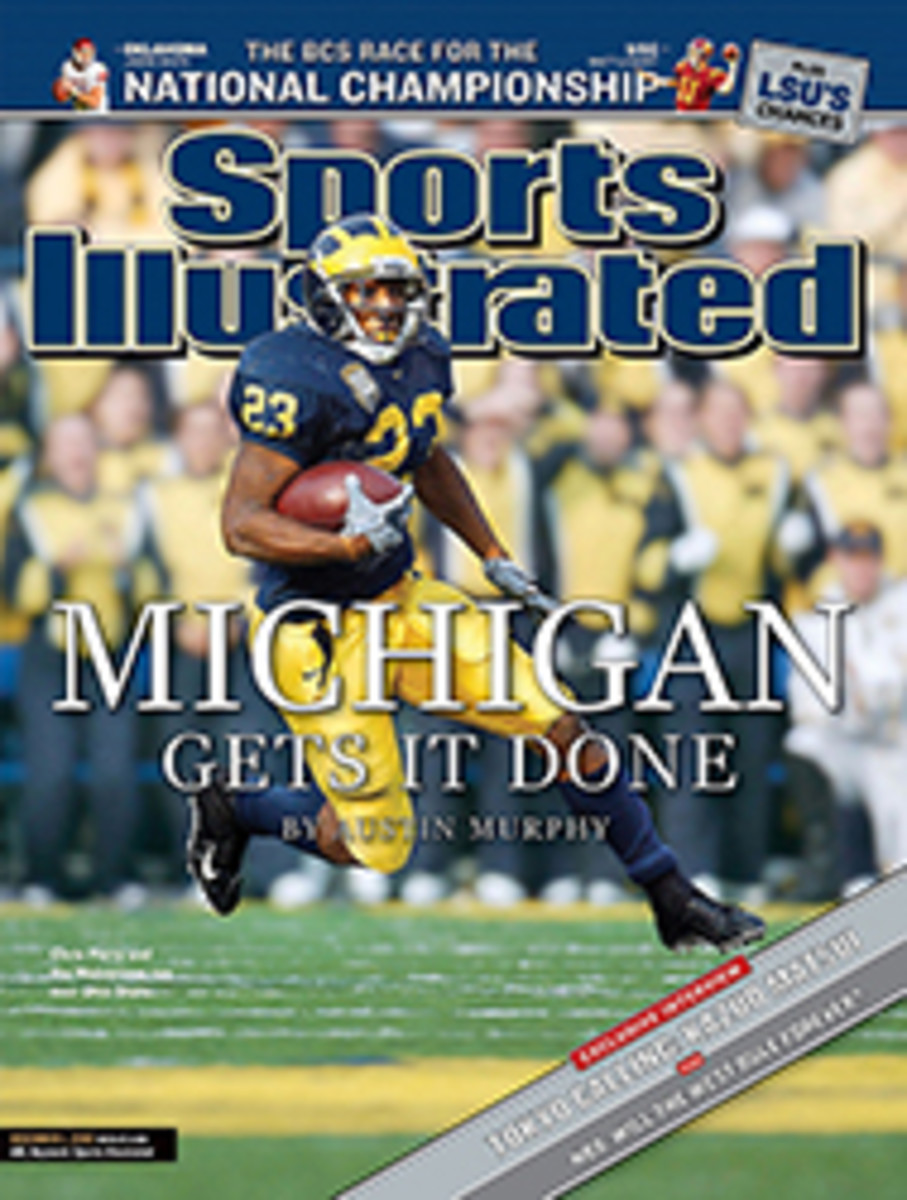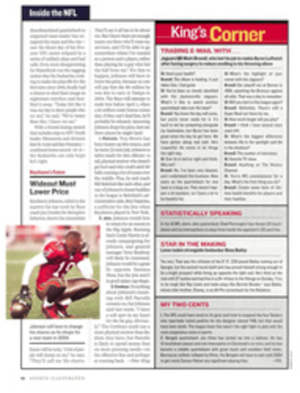
Black + White = Red A novelist tells how he became a color-blind cheerleader for the Hogs
When I was a young boy growing up in Little Rock, I always tried
to do whatever Mama told me. Most of the time I succeeded--that
is, until Mama started to mess with my love life.
It was 1969, I was 12 years old, and I had a boyhood crush on
the Arkansas Razorbacks football team. Mama, and everyone else
in my neighborhood of colored people (that's what we called
ourselves then), didn't like the Razorbacks because they were
lily-white; in 76 years of fielding a team, they had had but one
black player, a walk-on in '66. My neighbors pulled instead for
the all-black mighty Bearcats of Horace Mann High and the Golden
Lions of Arkansas AM&N, a historically black college in nearby
Pine Bluff.
But even though Mama tried her best to steer me away from the
Razorbacks--she wouldn't even let me listen to their games on
the big radio in the kitchen--they were my passion. I would read
legendary sportswriter Orville Henry's columns in the Arkansas
Gazette as if they were love letters from Miss America
contestants. Nothing was better than Saturday nights in the
fall, when I would sneak my tiny transistor radio into bed with
me and listen as the voice of the Razorbacks, Bud Campbell,
relayed every move my heroes made. Before I got into bed, I
prayed that my Hogs would win, and that my mother wouldn't hear
Mr. Campbell's muffled voice.
To me every Razorbacks win was a victory for my small,
misunderstood state. I was tired of my cousins in Michigan (where
I was born) calling Arkansas a hick place. Wins brought us
respectability and did something more important: They doused the
images of white students yelling and spitting at the nine colored
students trying to enter Little Rock's Central High in 1957. I
was an infant back then, but as I got older, I saw the pictures,
and people in my neighborhood talked of the ugly incidents as if
they had happened yesterday. I was embarrassed that my city was
known for hate when I felt there was so much love there.
So much love, that is, for everything except the University of
Texas and its burnt-orange-clad football team. The Longhorns are
so despised in Arkansas that true Hogs fans don't even wear
orange on Halloween. When my Razorbacks lost 15-14 to the (also
all-white) Horns in December 1969 in a showdown between the
nation's two top-ranked teams, I was mad--not at the Hogs but at
God and at everybody, black and white, in the enormous state of
Texas. Didn't they already have enough, being the home of the
Dallas Cowboys and big hair? With that one victory, our state
could have been known for something other than Central High and
the Little Rock Nine. I think even Mama felt sorry for me, as she
chastised my younger sisters, who teased me for crying over a
stupid football game.
In 1969 my Razorbacks finally gave a scholarship to Jon
Richardson, a black running back from Horace Mann. The next year,
the first that Jon was eligible for the varsity, I knew I had to
be there when he made his first appearance in the
cardinal-and-white uniform, so I took some of the money I had
saved for school clothes and purchased a ticket to see Arkansas
play Stanford at War Memorial Stadium in west Little Rock.
I was frozen with fear as I walked into the vast stadium and
found myself surrounded by white people of all shapes and sizes
decked out in Razorbacks attire that included red plastic hats in
the shape of Hogs' heads. I had never seen so many white
folks--or so many people of any color--in one place, and my eyes
searched without success to spot somebody who looked like me.
Even the boys and girls selling popcorn and peanuts were white.
Where were Jon's family and friends who had watched him score
touchdown after touchdown for the Bearcats? Didn't they know he
would do the same thing for the Razorbacks?
I located my seat at the top of the south end zone and squeezed
in between two large men who looked startled to see me. One of
them asked me if the Hogs were going to win, and I said, "Yes,
sir." He smiled and the knots of tension relaxed in my stomach. I
guess it didn't matter that I was black (as we were now being
called) and they were white. We were Razorbacks fans.
Something happened to me that evening that had never occurred
before: A white man hugged me. It happened after Arkansas had
scored a touchdown and everyone in the south corner of the end
zone was jumping for joy. His action certainly surprised me, and
from the I-can't-believe-I-just-did-that look on his face, I'd
say it surprised him, too. He quickly offered me an uncertain
half-smile and moved his eyes back toward the field.
Unfortunately, although Richardson caught a 37-yard touchdown
pass--and I was over the moon that he had brought the stadium to
a collective roar--the Hogs lost 34-28.
My love for the Razorbacks only grew stronger as I got older. I
turned down scholarships from several other schools to enroll at
Arkansas, and in my four years there I had perfect attendance at
home football games--something I never achieved in my classes. I
was proud that my freshman class included black football players
from Arkansas, Texas and Louisiana. Of course, the first time I
took a class with a real live Razorback, I had to tell myself to
breathe normally and not make a fool out of myself by doing
something silly like asking for an autograph.
While a student in Fayetteville, I enjoyed the experience of
seeing the Hogs beat such teams as Southern Cal, Oklahoma, Texas
A&M and Georgia. During my senior year, 1977, I became the first
black male Razorbacks cheerleader. The first time I helped lead
the team onto the field out of the huge block A formed by the
band, I felt lifted by the roar of the crowd--I think my feet
never touched the ground.
Today I make my living as an author of urban love stories, which
allows me to set my own schedule. When the Razorbacks play, I am
either in the stands, on the Internet checking the updates or
listening to the radio broadcasts by phone. I feel as though I'm
letting the team down when I'm not giving it my undivided
attention. I make sure my novels come out in the summer so that
my book tours will be completed before the first football is
kicked off.
The Hogs' coach of the last six seasons, Houston Nutt, has
deepened my pride in the Razorbacks. Coach Nutt, who is white,
tells his players, "Mix it up," when he sees them segregating
themselves in team meetings. On road trips he makes sure they
room with teammates of different races. Coach Nutt and I have
lived through our state's difficult racial transformation
together. When my family moved into a mostly white neighborhood
in Little Rock in the early 1970s, FOR SALE signs began to pop
up. One of the families in the neighborhood was the Nutts. My
sisters and I would see Houston and his brothers riding their
bikes down Thayer Street looking for a game of sandlot football
with the brothas in an adjoining neighborhood. Though the
complexion of the neighborhood had changed, the Nutt family did
not flee to the suburbs. Not surprisingly, when I talked to some
members of the Arkansas team recently, both black and white
players beamed when they spoke about playing for Coach Nutt.
Every good love story deserves a happy ending, but when it comes
to the Razorbacks and me there is no end in sight. This fall I
returned to my beloved university as writer in residence and
interim cheerleading coach. (Mama, now a huge Hogs fan, sent me a
housewarming gift: a stuffed Razorback that plays the school
fight song when you squeeze its hoof.) I smiled to myself one day
as I drove into Fayetteville from the north and saw the sign
boasting of the university's 38 NCAA track and field
championships and proclaiming the town the track capital of the
world. That record is exceptional, and the Hogs' 1994 NCAA
basketball title and runner-up finish the following year show how
strong the school is on the hardwood as well. But anybody who has
ever lived in the state knows that Razorbacks football is still
king, more treasured than shares in another Arkansas success
story, that little Bentonville-based company called Wal-Mart.
As I prepared to finish my first month back in my favorite college
town, I followed the football team to Austin. Standing on the
sideline throughout a glorious, sun-drenched afternoon, I watched
my two-touchdown-underdog Hogs knock the Longhorns all over their
home field during a 38-28 victory.
The excitement I felt reminded me of when I first fell in love
with the Razorbacks as a child. But the scene was quite
different. Unlike in the late '60s, the Hogs' fans in the end
zone were a beautiful blend of brown, black and cream. And after
every Arkansas touchdown I was hugged by several white men, not
one of whom had an I-can't-believe-I-just-did-that look.
Best-selling novelist E. Lynn Harris's latest book is a memoir,
What Becomes of the Brokenhearted.
COLOR ILLUSTRATION: ILLUSTRATION BY JOE CIARDIELLO
Razorbacks wins doused the images of white students spitting at
the nine colored students trying to enter Little Rock's Central
High in 1957.

